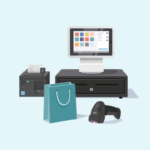Before You Brag About Your Magento POS, Read This First!
Magento’s position as the most popular e-commerce platform on the market is solid. Since the initial release in 2007, Magento has achieved a nearly 30 percent market share and a user base in the hundreds of thousands. The product is robust and the capabilities grow daily due to Magento’s roots as open-source software with a large community of contributing developers.
Our question today is centered on the large portion of Magento users who also operate a brick-and-mortar-store. The question is whether a true Magento POS exists.
In short, there is no true Magento POS. Magento is strictly an e-commerce platform and not point of sale software. In the absence of a true Magento POS, one can identify two separate types of POS systems that “integrate” or share information with Magento.
The first category is essentially “Magento front ends”. These are products that were written to leverage th e Magento database and applicable Magento functions while appearing to be outward-facing point of sale systems. Generally, they are on a tablet, the interface is attractive and they work fairly well with Magento. What these systems don’t do well is manage inventory. They also lack traditional POS software features and cannot stand alone as POS software.
e Magento database and applicable Magento functions while appearing to be outward-facing point of sale systems. Generally, they are on a tablet, the interface is attractive and they work fairly well with Magento. What these systems don’t do well is manage inventory. They also lack traditional POS software features and cannot stand alone as POS software.
The second category is standard point of sale software integrations. These systems stand alone as retail management systems but also integrate with Magento to facilitate e-Commerce sales. By extending Magento’s Application Program Interface (API), developers are able to share product data such as sizes, styles, quantities, prices, images, descriptions, and more with a Magento site. When something is sold online the sale flows from Magento down to the point of sale software where the sale is recorded. There are multiple variations on how this works but the two-way-communication is by far the most optimal situation for a small or medium-sized retailer. It creates efficient processes and significantly decreases your workload. In addition, these systems provide consolidated reporting across all sales channels, products, and vendors.











